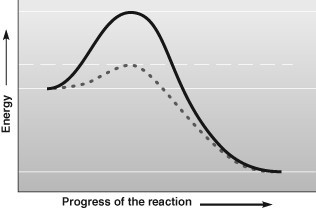The major difference between gram-positive and gram-negative bacteria is that:
a. the peptidoglycan layer in gram-positive bacteria is substantially thinner than in gram-negative bacteria.
b. gram-positive bacteria contain a periplas-mic space, whereas gram-negative bacteria do not.
c. flagella are only present in gram-positive bacteria.
d. gram-negative bacteria contain an outer membrane that functions as the cell's ini-tial barrier to the environment.
D
Gram-negative bacteria contain an outer membrane, but gram-positive bacteria do not.
You might also like to view...
Which of the following is true of both first- and second-division nondisjunction? (Choose all that apply)
A. Gametes are produced with extra chromosomes B. Gametes are produced with missing chromosomes C. Sister chromatids fail to separate D. Homologous chromosomes fail to separate E. Half of the gametes produced are wildtype, while half are mutated
You synthesize polyribonucleotides using a molar ratio of 3 Uracil :
1 Guanine. The resulting polyribonucleotide sequences are random but each polyribonucleotide follows the 3:1 ratio. When this mixture of polyribonucleotides is used as template for translation, proteins with different amino acid sequences are obtained. When you determine the amino acids present in the proteins, you obtain the frequencies for each amino reported in the table below. The frequency of phenylalanine was normalized to 1 and all other amino acids are reported as a frequency of occurrence compared to phenylalanine. As an example of understanding the data, the amino acid glycine frequency is 0.12, meaning that glycine was present in the mixture of polypeptides at a ratio of 12 glycine residues (amino acids) for every 100 phenylalanine residues (amino acids). Amino acid Frequency Phenylalanine 1.00 Leucine 0.37 Valine 0.36 Cysteine 0.35 Tryptophan 0.14 Glycine 0.12 Which one of the following statements about this experimentis true? A. The most likely codon present in the polyribonucleotides synthesized under these conditions is GGG. B. Codons consisting of one guanine and two uracils, in any order, are likely to encode for either valine, leucine, or cysteine. C. A codon for tryptophan is as likely to be present as is the codon for phenylalanine. D. Since only poly(G) and poly(U) RNA are present, the presence of valine shows ribosome slippage during translation.
____________________ do not have walls between their cells and as a result, many haploid nuclei from each hypha flow into each gametangium.
A. Puffballs B. Sac Fungi C. Basidiomycetes D. Zygote fungi E. Mycorrhiza
What is true about the data in the accompanying figure?

A) The solid line represents a reaction that has been catalyzed by an enzyme.
B) The dashed line represents a reaction that includes an enzyme and a cofactor.
C) Both lines represent endergonic reactions.
D) The energy of the products is higher than the energy of the reactants.